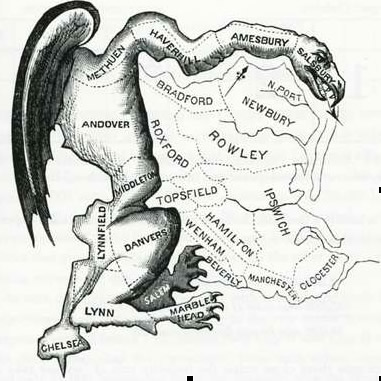|
Government : The Legislative Branch : Section One
The Structure of Congress

You’ll recall from unit 3 that Article I of the Constitution establishes the Legislative branch of government. It lists specific requirements for members of the two houses of Congress, and lists powers that Congress does and does not have. Those powers that are listed in the Constitution are known as the Enumerated Powers; they are also sometimes called the Expressed Powers because they are specifically expressed in the Constitution.
The United States Congress is the full name for the legislature of the federal government. It is a bicameral legislature made up of the House of Representatives and the Senate.
The House of Representatives:
The House has a total of 435 members. Each representative serves a two year term, and can be reelected without limits. In order to determine the amount of representatives each state has in the House, the census is used. Every ten years when the federal government conducts its census, or count of citizens in the country, the number of representatives each state has in the House can change. That is because the number of representatives for a state is based on the amount of people in that state. Congress apportions, or distributes, the seats after each census. The states are drawn into geographic regions. One representative is elected to represent each district of the state. After each census, the seats in Congress are reapportioned, or redistributed, to align with the decrease or increase in the states’ populations.
The Senate
The Senate is currently made up of 100 members. Senators are elected to a six year term and can be reelected without limits. Every state receives two senators regardless of its population. Senators are not elected by districts, but are elected at large, or by the whole state. Elections for Congress are held every two years, and approximately 1/3 of all Senate seats are up for election each time. Both seats from the same state are never up for election in the same year. Senators used to be elected by state legislatures, but following the adoption of the Seventeenth Amendment in 1913, voting citizens directly elect members of the Senate.
The House of Representatives is considered the lower house of Congress. Its members are up for election every two years, so they are constantly thinking about reelection. This makes them more aware of the concerns of their constituents, or the people in their districts. In order to be reelected to their position in Congress, representatives cannot vote against the wishes of their constituents very often. The Senate is considered the upper house of Congress. Senators are in office much longer, and are able to focus more of their attention on their job as legislators rather than on reelections. This gives them the ability to think about what is best for the government, not just what the people want. They are members of a smaller group, and therefore have more power.
The Constitution reads that each state gets two senators, so United States districts and territories do not have representation in Congress (although the House has several non-voting delegates from U.S. territories). This includes the District of Columbia (Washington D.C.), American Samoa, Guam, the U.S. Virgin Islands, and Puerto Rico. Attempts to pass amendments to change this have failed over the years.
Congressional Elections
Following a census, the federal government tells each state how many representatives they have in the House. States then draw the boundaries for each of their Congressional districts. The districts are to be drawn so that each has roughly the same number of people. Districts can be redrawn following the next census if there is a shift in where people live and the number of people in various districts changes.
In the past, states did not necessarily follow the rules regarding establishing districts. The political party in power in a state may have intentionally drawn district boundaries to help their candidates, or hinder the other party’s candidates. This process is called gerrymandering. Gerrymandering can be done in two ways:
- Creating districts with as many voters from one party/group as possible into one district in order to reduce their effectiveness in other districts
- Spreading out voters of a certain type, such as by party, race, etc., so that their vote is not as effective because their numbers are small in each district
Gerrymandering makes elections less competitive. Incumbents are fairly secure in their Congressional seats and do not have to worry about winning the support of voters in their district because their district is packed with their supporters. This reduces the amount of campaigning that is done and also decreases voter turnout. Many people would decide not to vote because they felt like their vote did not count. Although the Supreme Court declared gerrymandering unconstitutional in Wesberry v. Sanders (1964) and several other decisions, efforts to redraw districts for partisan advantage still continue.

Congressional elections are held every even numbered year on Election Day in November. Since presidential elections are held every four years, there is a Congressional election at the same time, and then once in the middle of the president’s term of office. A midterm election is that which is held in the middle of the president’s term. If the party controlling Congress changes in the middle of a president’s term it can affect what the president is able to accomplish. In 1994, the midterm election gave the Republicans control of the legislative branch during Democratic president Bill Clinton’s first term as president. Another example of this was the 2006 midterm election which saw the Democrats gain power in Congress during Republican president George W. Bush’s second term in office. Both of these examples saw the opposite party of the president gain Congressional power, thus hindering the president’s ability to move along his own agenda.
Terms of Congress
The Twentieth Amendment of the Constitution states that congressional terms begin at noon on January 3rd of every odd numbered year. We refer to congressional terms using ordinal numbers. For example, the term from 2005 – 2007 was called the “109th Congress,” the one before that (lasting from 2003 – 2005) was called the “108th Congress,” etc. Each congressional term is divided up into two one-year sessions. The president can call special sessions if there is an urgent need for congressional action on some important issue. This is very rarely done.
Typically, Congress meets throughout the entire year. They take breaks during the session that are called recesses. In order to assure that each house of Congress deals with the issues they need to deal with, and act on pieces of legislation that need their action, neither house can adjourn for more than three days without the approval of the other house. They also may not meet anywhere other than in the Capitol.
Historically, the composition of Congress has not reflected the racial and ethnic diversity of the United States. Despite the fact that this country has a large number of minorities, the majority of members of Congress are white males. Most of them are married, have college degrees, are Christian (particularly Protestants), were born in the United States, have a strong background of previous political experience, and come from the fields of business, education or public service.
Members of Congress have certain privileges as a part of their office. They may not be arrested in specific situations (such as on the way to session), except for cases of treason, felony or breach of the peace. They have the right to freedom of debate without limits. This means that they may not be sued for slander for comments they make during discussions in the House or Senate chamber. They also have access to non work-related perks such as several free parking spaces at the Capitol, private gyms, dinner allowances, discounts on postage, etc. Members of Congress receive these perks on top of their salary, which is currently $174,000.
Within their job, the members of Congress serve in five different roles:
- Legislators – they make laws.
- Committee members – they serve on committees within Congress and preview bills before they go to the whole house for a vote; they also practice legislative oversight, or they watch the actions of the rest of the government to make sure they are acting appropriately.
- Representatives of their constituents – they bring the concerns of the people of their district to Congress.
- Servants of their constituents – they are expected to act and vote the way their constituents wish for them to, and they help them solve problems they may be experiencing with the federal government.
- Politicians – they work for reelection and “play the political game.”
There are various types of committees within Congress:
- Standing Committee – the regular committees that always exist
- Select Committee – a committee appointed for a special, temporary purpose
- Joint Committee – a committee made up of members of both houses of Congress, usually for the purpose of studying an issue before it comes up to house floor
- Conference Committee – a temporary committee that is created when both houses of Congress pass different versions of a similar bill. (see section 4)
The work of Congress is very difficult and all encompassing. Each term, Congress deals with over 10,000 bills, or proposed laws, on average. Not all of these bills, of course, are voted on by the entire House. In section four of this unit we will examine the procedure for how a bill becomes a law.
 Discussion 1 – Why was gerrymandering made illegal? What problems could result if this practice were used? Why does it make elections unfair and inaccurate? Discussion 1 – Why was gerrymandering made illegal? What problems could result if this practice were used? Why does it make elections unfair and inaccurate?
 View this presentation about what Congress is and how it is structured. View this presentation about what Congress is and how it is structured.
 Now it’s time to take the quiz on section 1. When you are finished, proceed to section 2. Now it’s time to take the quiz on section 1. When you are finished, proceed to section 2.
Go to next section |